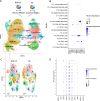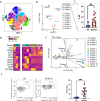Single-cell profiling identifies a CD8bright CD244bright Natural Killer cell subset that reflects disease activity in HLA-A29-positive birdshot chorioretinopathy
- PMID: 39085199
- PMCID: PMC11291632
- DOI: 10.1038/s41467-024-50472-0
Single-cell profiling identifies a CD8bright CD244bright Natural Killer cell subset that reflects disease activity in HLA-A29-positive birdshot chorioretinopathy
Abstract
Birdshot chorioretinopathy is an inflammatory eye condition strongly associated with MHC-I allele HLA-A29. The striking association with MHC-I suggests involvement of T cells, whereas natural killer (NK) cell involvement remains largely unstudied. Here we show that HLA-A29-positive birdshot chorioretinopathy patients have a skewed NK cell pool containing expanded CD16 positive NK cells which produce more proinflammatory cytokines. These NK cells contain populations that express CD8A which is involved in MHC-I recognition on target cells, display gene signatures indicative of high cytotoxic activity (GZMB, PRF1 and ISG15), and signaling through NK cell receptor CD244 (SH2D1B). Long-term monitoring of a cohort of birdshot chorioretinopathy patients with active disease identifies a population of CD8bright CD244bright NK cells, which rapidly declines to normal levels upon clinical remission following successful treatment. Collectively, these studies implicate CD8bright CD244bright NK cells in birdshot chorioretinopathy.
© 2024. This is a U.S. Government work and not under copyright protection in the US; foreign copyright protection may apply.
Conflict of interest statement
The authors declare competing interests.
Figures






References
MeSH terms
Substances
Grants and funding
LinkOut - more resources
Full Text Sources
Research Materials
Miscellaneous

